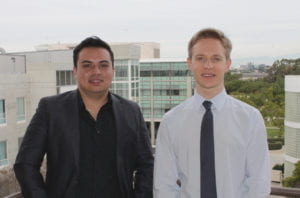UCI-Penn study in Science reveals natural process for scar-free wound healing
Targeting body’s skin regeneration responses could also have anti-aging applications

Irvine, Calif., Jan. 5, 2017 — Scars are often the unwanted and permanent result of wound healing, but University of California, Irvine and University of Pennsylvania researchers have discovered a natural regeneration process that stimulates scar-free skin repair.
Their study results, which appear in Science, point the way toward possible clinical treatments for scar-free wound healing, a highly desirable yet unmet need.
UCI’s Maksim Plikus, Penn’s Dr. George Cotsarelis and their colleagues identified in mouse studies never-before-seen cellular and molecular processes in which large wounds in adult mice regenerated nearly normal-looking skin, complete with new hair follicles and fat tissue. Ultimately, the center of the wound became nearly indistinguishable from normal, unwounded skin.
How did this occur? Christian F. Guerrero-Juarez, a graduate student in Plikus’ lab who worked closely on the project, explained: “Typically, myofibroblasts, the primary cell type found in wounds, were thought to be incapable of becoming other cell types. However, our team found that wound myofibroblasts can efficiently and stably convert into new distinct cell types, specifically new adipocytes, which are the fat-laden cells necessary for healthy skin.”

Raul Ramos / UCI
Guerrero-Juarez said their study established that wounds with hair follicles produce the instructive factors that can reprogram myofibroblasts into adipocytes. Critical for driving the rewiring of cells’ identity is bone morphogenic protein signaling. In skin wounds, hair follicles secrete large amounts of these BMP molecules. The fact that hair follicles act as the natural source of BMPs explains why hairless wounds cannot regenerate adipocytes.
“Essentially, we can manipulate wound healing so that it leads to skin regeneration rather than scarring,” said Cotsarelis, chair of dermatology and Milton Bixler Hartzell Professor of Dermatology at Penn and principal investigator on the project. “The secret is to regenerate hair follicles first. After that, the fat will regenerate in response to the signals from those follicles.”
Plikus, an assistant professor of developmental & cell biology at UCI, said, “In culture conditions, exposure of human fibroblasts derived from keloids, a type of skin scar, to either pure BMP or to human hair follicles is sufficient to drive their reprogramming toward new adipocytes. This shows that our findings from mice are translatable to humans.”
He noted that regenerating fat cells in skin can be beneficial for conditions beyond scarring. The process could potentially become a new anti-aging treatment, as the formation of deep wrinkles is thought to result from permanent loss of skin fat. Without underlying fat, the skin’s surface shrinks and wrinkles like a deflating balloon. Another recent study in Science, to which Plikus’ lab contributed, showed that, beyond their cosmetic value, fat cells possess strong antimicrobial properties that help skin fend off infection.
The next step is to translate these basic research findings into clinical approaches for treating healing wounds and aging skin in patients, but Plikus said it would take more time.
“Theoretically, this can be achieved via injections of signaling molecules directly inside the scar, such as with a small insulin syringe (similar to how Botox injections are now done),” he said. “Also, small-molecule agonists and antagonists that modulate signaling pathways critical for fat cell formation can be potentially developed into cream formulations.”
A complete list of authors can be found in the study text. The work was supported in part by National Institutes of Health grants, a Dermatology Foundation research grant, an Edward Mallinckrodt Jr. Foundation grant and a Pew Charitable Trust grant to Plikus.
About the University of California, Irvine: Founded in 1965, UCI is the youngest member of the prestigious Association of American Universities. The campus has produced three Nobel laureates and is known for its academic achievement, premier research, innovation and anteater mascot. Led by Chancellor Howard Gillman, UCI has more than 30,000 students and offers 192 degree programs. It’s located in one of the world’s safest and most economically vibrant communities and is Orange County’s second-largest employer, contributing $5 billion annually to the local economy. For more on UCI, visit www.uci.edu.
Media access: Radio programs/stations may, for a fee, use an on-campus ISDN line to interview UCI faculty and experts, subject to availability and university approval. For more UCI news, visit wp.communications.uci.edu. Additional resources for journalists may be found at communications.uci.edu/for-journalists.